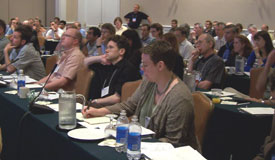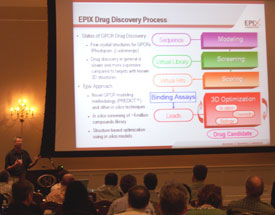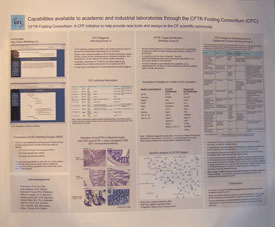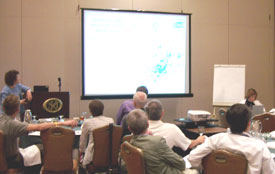Researchers Present Scientific Data at 2008 Williamsburg Conference
From May 30th to June 3rd, more than 110 scientists from academia and industry gathered at the 2008 Williamsburg Conference to present and exchange in-depth research on cystic fibrosis.
The 2008 conference focused entirely on outstanding questions related to Cystic Fibrosis Transmembrane conductance Regulator (CFTR), the key protein associated with CF, and the role academia and industry play in answering those questions.
“It’s a pretty exciting time for people who are CFTR scientists," said Diana Wetmore, vice president of alliance management for Cystic Fibrosis Foundation Therapeutics, Inc. (CFFT), the nonprofit drug discovery and development affiliate of the Cystic Fibrosis Foundation. "CFTR is an incredibly complex protein, but this group of researchers is learning more about it every day. Soon, we may be able to use that knowledge to develop a therapy that could cure CF.”
To learn more about what was discussed at the 2008 Williamsburg Conference, read further.
Nurturing Industry and Academic Collaborations

CF researchers take notes as presenters talk about their
various collaborative efforts. |
The Foundation has made it a priority to help build relationships between academic scientists and researchers who work in industry. Williamsburg was an opportunity to prompt people who hold different pieces of the CFTR puzzle to work together and advance drugs that affect CFTR.
“The Williamsburg Conference is exciting and extremely relevant for those involved in the CF research community. Not only are the scientists here who have been doing all the basic science work all these years, but many of the companies, like Vertex, PTC Therapeutics, EPIX and CombinatoRx, who are working on CF are here, too,” said Melissa Ashlock, vice president of drug discovery for CFFT.
Ashlock added, “Each group will have a chance to hear what the other is working on. The companies are hungry for information that will help them move forward, and the academics are hungry for information that will help them better understand CFTR.”
During a small working group discussion, members from both academia and industry discussed how science is accomplished in a collaborative fashion, and how best to translate that to CF research sponsored by the Foundation. An important aspect of a successful collaboration is having “a common goal and a shared mission,” explained Spencer Emtage of SGX Pharmaceuticals.
Understanding how groups measure success also is important to successful collaborations. In academia, science is supported by grants, and grants are acquired through published research. However, in industry, success is measured by project progression and how quickly compounds make it into the clinic.
Participants in the small group discussion grappled with how to balance these different measures of success and talked about using this information to help strengthen partnerships.
“The Foundation has been critical in a number of productive collaborations,” said Jane Staunton of CombinatoRx. Through these collaborations, scientists can tackle the difficult questions surrounding CFTR, and bring new treatments—and possibly a cure—for CF.
back to top
A New Way of Tackling Drug Discovery
In the search for compounds that may address the basic defect in CF, the Foundation has explored several different approaches, including a innovative method that uses computer modeling to discover novel compounds that may treat CF.
“Drug discovery falls into the screening approach—looking for a needle in a haystack—and into rational drug design, or a structure-based approach,” explained Ashlock. “The Williamsburg conference invites scientists to explore both approaches, helping us discover the best ways to find new drugs that affect CF.”

Harold Senderowitz, senior director of computations
development at EPIX Pharmaceuticals, Inc. presents
data based on the company's computer-aided drug
development process. |
Traditionally, scientists use cell-based assays (tests that examine the chemical activity of a compound) or study non-mammalian cells (like yeast) to determine if a compound has potential to treat CF.
Rather than running one assay at a time to explore hundreds of thousands of compounds, scientists can use high-throughput screening—an automated process that can screen large libraries of compounds much faster.
In 1998, the Foundation made early investments in this cutting-edge approach. VX-770 and VX-809, potential therapies developed by Vertex Pharmaceuticals that address the basic defect in CF, are results of that investment.
Another method of finding potential drugs is through computer modeling and simulation. In January 2008, EPIX Pharmaceuticals, Inc., with Foundation support, announced the completion of a full-length 3-D computerized model of the CFTR protein.
EPIX scientists are using the model to identify sites within the Delta F508 mutation of CFTR, the most common mutation in CF patients, which may be good targets for treatment. They can then search their libraries of chemical compounds for small molecules that may work on those sites.
“EPIX’s computerized model of CFTR is as cutting-edge as you can get,” said Robert J. Beall, Ph.D., president and CEO of the Foundation. “We look forward to their efforts to use unique structure-based technologies to identify molecules that may correct the faulty protein in CF—and potentially create new therapies for the disease.”
Already EPIX is advancing in its drug discovery program. During a working group session, EPIX presented data for a lead compound series named EPX-D, a dual-acting potentiator-corrector that aims to allow Delta F508 CFTR to function correctly at the cell membrane.
Many of the drugs the Foundation is studying fall into the category of poteniators, drugs that restore the function of the malformed CFTR, or correctors, drugs that move the defective CFTR protein to its proper place in the cell. EPIX’s novel finding may cause researchers to revisit how they classify compounds and where to focus their efforts.
back to top
CFTR Folding Consortium

Poster detailing resources available to the CF research
community through the CFTR Folding Consortium. |
In another example of a successful collaboration, the Foundation-supported CFTR Folding Consortium, or CFC, presented a talk called “New Tools for CFTR Analysis.” During the presentation, Eric Sorscher, M.D. of the University of Alabama at Birmingham, spoke about the CFC’s role in the Foundation’s initiative to help provide new tools and assays to the CF scientific community.
The CFC is composed of a group of investigators from various academic institutions across the country who study cystic fibrosis. The consortium focuses on misfolded proteins, like the Delta F508 mutation of CF, the most common mutation in people with the disease.
The goal of the CFC is to develop and provide various tools to CF researchers that will facilitate the understanding of why CFTR mutants misfold and how to correct that misfolding.
“Key resources that enable scientists to study misfolded proteins are made available through the CFC with the expectation that results will be accessible to the public and not held private for publication reasons,” explained Chris Penland, director of research for CFFT. “Multiple labs are working together, sharing data prior to publication and providing input to optimize the resources available to the CF research community. This group is really pushing CFTR work ahead at a fast pace.”
For more information about the CFTR Folding Consortium, visit www.cftrfolding.org.
back to top
Understanding How CFTR Modulators Work
An overarching theme of the 2008 Williamsburg Conference was understanding how potential treatments modulate, or change, CFTR activity. Currently, the CF research community is working on two classes of modulators: correctors and potentiators. But how do these drugs work? What dosage of corrector or potentiator drug is needed to restore CFTR function? Is one drug expected to correct many mutations? CF scientists grappled with these questions over the four-day conference – exchanging answers that could better guide their research.

In a small working group discussion, researchers discuss
the effects of potentiators and correctors on CFTR activity. |
In his presentation on Vertex’s CFTR potentiator, VX-770, Fred Van Goor of Vertex Pharmaceuticals, Inc. hypothesized that if the levels of mutant CFTR are increased by 10 percent, there may be enough CFTR activity to restore mucus transport in CF patients.
“As we learn more about the dose-response relationship between CF patients and lab experiments, we’ll be able to better estimate how much correction is actually necessary,” said Van Goor in his discussion about clinical trials of VX-770.
Researchers discussed not only how to modulate CFTR, but where in the cell CFTR modulators should act. Studying CFTR’s structure can provide scientists with information about where interventions may be most effective.
Additionally, researchers explored what might happen once CFTR is corrected. Will there still be a cycle of infection and lung damage that can’t be reversed, or does fixing CFTR allow the CF patient to fully recover, reversing the effects of the disease?
These are all questions that still need to be addressed, and conferences like Williamsburg are allowing the CF research community to move closer to definitive answers.
back to top